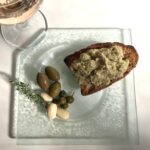 The green olive spread from Provence known as tapenade verte is delightful at cocktail hour on warm summer evenings. Like its cousin, tapenade noire, it is usually served on toast, accompanied by a chilled dry rosé or white from the region, or a local apéritif. And the good news is that tapenade verte can be prepared in just five minutes. You blend the olives with ground blanched almonds, capers, thyme, black pepper and olive oil — et voilà.
The green olive spread from Provence known as tapenade verte is delightful at cocktail hour on warm summer evenings. Like its cousin, tapenade noire, it is usually served on toast, accompanied by a chilled dry rosé or white from the region, or a local apéritif. And the good news is that tapenade verte can be prepared in just five minutes. You blend the olives with ground blanched almonds, capers, thyme, black pepper and olive oil — et voilà.
Tapenade verte / Green olive spread from Provence
For me, tapenade verte is more than a culinary experience. Just the thought of it conjures up memories of Provence — the lavender fields, the chirping cicadas, the olive trees, the warm Mediterranean breezes. Lazy evenings when the light lingers as friends gather for l’heure de l’apéritif, which can start early and often goes on for far more than an hour.
I like to replicate that experience here in Paris by making tapenade in my own kitchen and inviting friends over for drinks on the veranda. (It’s not Provence, but heck — I’ve got a lavender plant out there, as well as some Mediterranean herbs.) When I have time, I go to the market in search of picholines or Lucques, fruity olives from Provence with an unbeatable flavor. But there’s more good news — tapenade verte may also be made with normal green olives out of a jar. The results are almost as spectacular.
Now let’s talk about drinks, starting with wine. If you’d like to go local, regional rosés include the omnipresent Côtes de Provence, which encompasses many châteaux. The most chic at the moment is probably Château Minuty, which costs about €15 a bottle at my local supermarket — more than double the price of a simpler Côtes de Provence. Other pricey options include Bandol, named for its sunny seaside town, and Porquerolles, produced on an island about a 20-minute ferry ride from the Mediterranean port of Hyères.
 If you prefer white, choose a crisp, fruity variety. Or you may like to serve pastis, the oh-so-Provençal anise-flavored apéritif. Pastis, of which there are many varieties (Ricard, Casanis, Pernod, etc.), comes out of the bottle deep yellow but turns a cloudy pale yellow when water is added. Pour about an inch (2.5 cm) of it into a glass, add ice and top up with water. This goes brilliantly with tapenade — green, black or both.
If you prefer white, choose a crisp, fruity variety. Or you may like to serve pastis, the oh-so-Provençal anise-flavored apéritif. Pastis, of which there are many varieties (Ricard, Casanis, Pernod, etc.), comes out of the bottle deep yellow but turns a cloudy pale yellow when water is added. Pour about an inch (2.5 cm) of it into a glass, add ice and top up with water. This goes brilliantly with tapenade — green, black or both.
As for ingredients, it’s best to start with whole blanched almonds and grind them yourself. You’ll get more crunch and more flavor. And fresh thyme is far better than dried. I grow a pot of it on my balcony. If you’d like to start a plant, you could try Thymus longicaulis from plant d’Avenir (‘plant of the future’), a climate-aware online garden shop that ships to destinations in France and Europe.
Once you’ve made your tapenade, it will keep for several weeks in the fridge — and it’s far superior to the store-bought variety. In fact, you may want to double the recipe!
Happy cooking.



